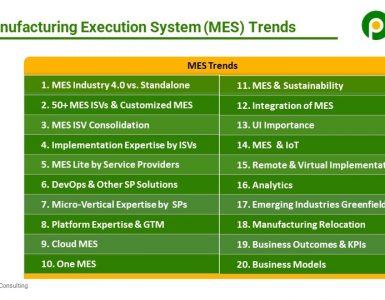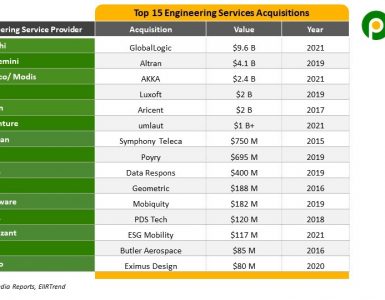The engineering services market was traditionally catered by India-centric and Europe-centric engineering service providers. There is a new entry now of Global MNCs, and they are building their capabilities mainly with acquisitions of Europe-centric service providers
The below chart shows five major acquisitions of Europe-centric engineering service providers in the last three years, along with the remaining top 10 Europe-centric engineering service providers in the market.

Except for EPAM, all other Europe-centric service providers are facing challenges amidst changing business environment
- Low-cost destinations. Client’s preference of moving more engineering work offshore and other low-cost destinations as a cost optimization lever is a major challenge. Pandemic has made enterprises revisit their earlier assumptions of what can or can’t be offshored.
- Low margins and low valuations. Most European service providers have single-digit to low double-digit margins ( 5-15%) compared to medium double-digit to the high double-digit (15% -25%) for India-centric pure-play service providers. While the valuations of Indian pure-play engineering service providers are sky-high, the valuation of European pure-play engineering service providers is not.
- Declining market share. The entry of Global MNCs and consistent growth of India-centric engineering service providers are contributing factors for the change in the engineering service provider market share mix. The market share of Europe-centric engineering service providers is on the decline.
What can European-centric Engineering Service Providers Do?
- Expand offshore and low-cost destinations footprints aggressively. When customers prefer low-cost destinations both for their internal work as well as with their work with service providers, the inability to offer them will hurt Europe-centric service providers. They are already late to the party but then can catch up either organically or by acquiring small firms. Many large European IT firms expanded offshore with acquisitions of mid-tiers Capgemini – IGate, Atos- Syntel. Engineering service providers can also replicate this. Expanding into offshore and low-cost destinations will also help in increasing margins and valuations.
- Move into digital and other high-growth segments. Europe-centric service providers are strong on the traditional mechanical engineering side. Now growth is in digital engineering, be it software product engineering in software or Industry 4.0 in manufacturing. The backbone of all digital transformation is digital engineering, and Europe-centric service providers need to be present there. Also, each vertical has new emerging areas like EV, Autonomous Cars, 5G, etc. Then there are megatrends like Sustainability. All these areas have a high engineering services potential, and Europe-centric service providers need to capitalize on that. Again, it can be organic or with tuck-in acquisitions.
- Change business model with large deals and 360-degree partnerships. Most Europe-centric service providers have big clients and high revenue per client, but mostly the business model is T&M or onsite resource augmentation. They don’t have that many project-based engagements, and large deals as some India-centric engineering service providers have. These project-based large deals and partnerships help to develop competency, ensure predictability, and drive margins upwards.
- Geographical expansion beyond Europe. Most Europe-centric engineering service providers focus primarily on Europe for business which is less than 50% of the addressable market in most of the segments. There is a market out there in North America and APAC, including Japan, China, Australia. In some verticals such as Oil & Gas, Natural Resources, the Middle East, and other parts of the Rest of the World (RoW) are also important. Most India-centric service providers get the majority of their revenue from North America. Also, recent geopolitics events favor European service providers in China. A few months back, A Finnish service provider Etteplan did an engineering services captive buyout in China.
- Patents/ Solutions accelerators. Since many Europe-centric service providers work in resource augmentation models, they don’t invest enough in filing patents, R&D, developing solution accelerators which are critical for going up in the value chain and winning project-based engagements and large deals.
- Full services stack across the lifecycle. Europe-centric service providers should consider developing a full EIIR services stack across the product lifecycle from business consulting, product design, engineering, manufacturing, development, platform implementation, supply chain, and service operations. That way, they can become strategic partners to their customers and also increase their share of customers’ wallets.
- Marketing, branding, and talent attraction. Europe-centric service providers don’t spend that much on marketing, thought leadership, and developing a brand as compared to Global MNCs and India-centric service providers. That negatively impacts all aspects from the pipeline, opportunities, pricing, deals, and even talent attraction. In this supply-constrained market, when most organizations are suffering from talent scarcity, a good brand can help in attracting and retaining talent also.
Bottom Line: There are changes in the market and competitive environment. Many Europe-centric service providers will have to transform themselves to capture the next phase of growth of the engineering services market. Otherwise, they will remain acquisition targets for others.





 Pareekh Jain
Founder of Pareekh Consulting & EIIRTrends
Pareekh Jain
Founder of Pareekh Consulting & EIIRTrends
Add comment